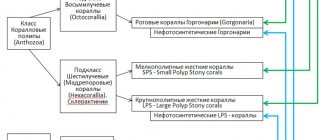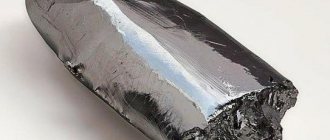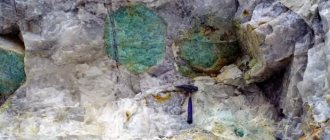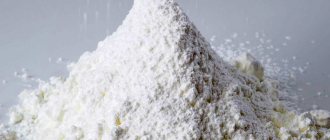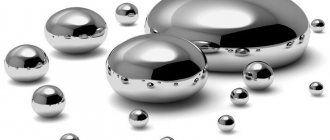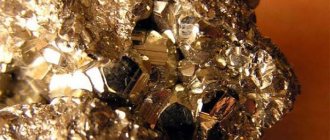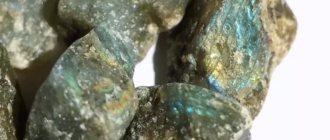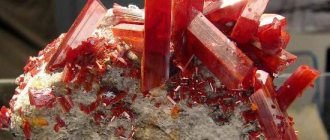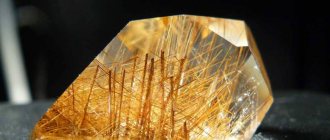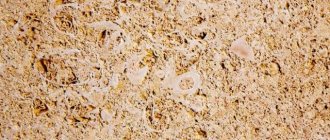It is not gold or platinum that are the most expensive metals from D.I. Mendeleev’s table, but osmium metal. This is a rare and expensive metal of silver-white color with a gray tint of blue tint. Chemists consider this metal to be noble, belonging to the platinum group.
Consists of several isotopes. They are very difficult to separate, which is reflected in the cost. The most popular isotope is Osmium-187.
It is assumed that 0.5% of the mass of the earth's crust consists of osmium, and it is located in the core. The proportion between size and weight is surprising. A kilogram of the compound is comparable in size to the average size of a chicken egg. A 0.5 liter container filled with osmium powder weighs more than 15 kg. But the desire to cast dumbbells from such a convenient material in terms of size/weight ratio immediately disappears not only because of the price of the powder, for some this is not a problem, but because of its extreme rarity and inaccessibility.
What is
Osmium is a noble metal, a platinoid.
76th element of the periodic table. The canonical description is brilliant silver-white with a bluish tint.
But in different forms it looks a little different:
- The ingot is distinguished by its dark blue silver color.
- Crystals obtained in the laboratory are silver-blue.
- The powder is dark purple.
International name – Osmium (Os).
It is a simple substance consisting of seven isotopes.
The name of the chemical element in ancient Greek is ὀσμή, which means “smell”.
Its origin is due to the property of the powder, when interacting with other elements, to emit a pungent, disgusting odor.
Isotopes
There are 7 known isotopes of chemical element No. 76: Os-184 (its percentage content in the metal is the lowest), Os-186, Os-187 (radioactive), Os-188, Os-189 Os-190, Os-192 (the highest percentage content). They can exist separately, constituting varieties of natural osmium, but it is difficult to isolate any one isotope from the metal, due to the fact that they have almost the same physical and chemical properties.
The most valuable isotope is Os-187. 30% of it goes to the needs of science, the rest is used for medical and industrial purposes. It was first obtained in Germany from Norwegian molybdenum ores. Currently, Kazakhstan has a monopoly on the sale of Os-187.
Scientists have recently discovered that some isotopes emit alpha radiation, but with half-lives of trillions of years they are considered relatively stable elements.
Story
Osmium was discovered by scientists while studying platinum ore.
The first (1803) were British chemists:
- William Wollaston experimented with the raw material, intending to extract pure platinum. The experiment of dissolving platinum with aqua regia was a success, but the chemist was interested in the undissolved black powder sediment. The scientist suggested that these were elements unknown to science.
- Smithson Tennant obtained the same results . According to his version, the undissolved sediment was graphite. However, further manipulations showed that it was a metal (or metals).
Their French colleagues Vauquelin, Fourquois and Collet-Descoti considered the resulting substance to be a single chemical element. As the platinum dissolved, they detected black smoke. Therefore, the substance was dubbed pten, that is, “volatile.”
Further experiments proved that this is a compound of two metals, called osmiridium. Smithson Tennant was the first to separate them, obtaining pure iridium and osmium.
Thus ended the history of the discovery of metal.
Discoverer Tennant came up with the name. He was unpleasantly struck by the amber (like bleach or rotting radish), emitted when the sediment was dissolved with water or acid and the powder of this metal during oxidation in air.
The curiosity of chemists leads to...
The history of the discovery of metal is simple and unpretentious.
Chemists - Tennant and Wollaston - worked with native platinum, influenced the metal by any means and saw what would come of it. The result was the discovery of a new metal.
In parallel, French chemists A.F. de Fourcroix and Vauquelin became interested in researching platinoids. As a result of experiments, scientists established the existence of an unknown element in solutions from working with raw platinum. The lucky discoverers even gave the name to the discovered metal - “pten”, but further research showed that it was not a new metal, but a mixture of iridium and osmium.
During the research, the osmium compound OsO4 was isolated, which has a pungent, persistent, and very unpleasant odor. Mix bleach with rotten radish, and you will get a distant sensation from inhaling the vapors of this compound.
Delicate scientists named the new metal “osmium,” translated from ancient Greek as “smell.”
Physico-chemical characteristics
Osmium is the heaviest, hardest, chemically stable, refractory, but brittle in the platinum family.
Chemical activity is determined by the form of the substance:
- Metal osmium does not oxidize in air, does not dissolve in acids, and does not react to alkalis.
- Powder is the most active: it easily interacts with oxygen, nitric, sulfuric acids, and other chemical elements. This is a good catalyst.
The metal never ceases to shine even at high temperatures.
| Properties of the atom | |
| Name, symbol, number | Osmium / Osmium (Os), 76 |
| Atomic mass (molar mass) | 190.23(3) a. e.m. (g/mol) |
| Electronic configuration | [Xe] 4f14 5d6 6s2 |
| Atomic radius | 135 pm |
| Chemical properties | |
| Covalent radius | 126 pm |
| Ion radius | (+6e) 69 (+4e) 88 pm |
| Electronegativity | 2.2 (Pauling scale) |
| Electrode potential | +0,850 |
| Oxidation states | 8, 6, 4, 3, 2, 0, −2 |
| Ionization energy (first electron) | 819.8(8.50) kJ/mol (eV) |
| Thermodynamic properties of a simple substance | |
| Density (at normal conditions) | 22.587/22.61 g/cm³ |
| Melting temperature | 3306 K (3033 °C) |
| Boiling temperature | 5285 K (5012 °C) |
| Ud. heat of fusion | 31.7 kJ/mol |
| Ud. heat of vaporization | 738 kJ/mol |
| Molar heat capacity | 24.7 J/(K mol) |
| Molar volume | 8.43 cm³/mol |
| Crystal lattice of a simple substance | |
| Lattice structure | hexagonal |
| Lattice parameters | a = 2.734 c = 4.317 |
| c/a ratio | 1,579 |
| Other characteristics | |
| Thermal conductivity | (300 K) (87.6) W/(m K) |
| CAS number | 7440-04-2 |
The density of osmium is twice that of lead, and almost three times that of iron. Its hardness is comparable to silicon.
Osmium is the densest and heaviest metal on Earth. This characteristic is ensured, among other factors, by a close-packed hexagonal crystal lattice.
A cube of pure osmium with an edge of 8 cm is heavier than a 10-liter bucket of water.
Oxidation states of osmium
| Oxidation state | Connection example |
| −2 | Na2[Os(CO)4] |
| −1 | Na2[Os4(CO)13] |
| 0 | Os3(CO)12 |
| +1 | OsI |
| +2 | OsI2 |
| +3 | OsBr3 |
| +4 | OsO2, OsCl4 |
| +5 | OsF5 |
| +6 | OsF6 |
| +7 | OsOF5, OsF7 |
| +8 | OsO4, Os(NCH3)4 |
Application
- High hardness and exceptional refractoriness make it possible to use osmium as a coating in friction units.
- It is used as a catalyst for the synthesis of ammonia, hydrogenation of organic compounds, and in catalysts for methanol fuel cells.
- The alloy "osram" (osmium with tungsten) was used to make incandescent lamp filaments.
- There is information about the use of osmium for military purposes, as part of artillery shells and missile warheads. It is also used in electronic equipment for aircraft and rocketry.
- Component of super-hard and wear-resistant alloys with iridium and ruthenium.
- Osmium tetroxide is used in electron microscopy for recording biological objects.
- An alloy of platinum (90%) and osmium (10%) is used in surgical implants such as pacemakers and in pulmonary valve replacement.
- The alloy of osmium with aluminum has unusually high ductility and can be stretched 2 times without breaking.
Metal in nature
Osmium is not represented in nature as an independent “player”.
It is always part of the rock composition with other noble metals:
- Copper, nickel, molybdenum ores. This is the main source of metal.
- Osmium's own metals are sysertskite and nevyanskite. In Nevyanskite the proportion of osmium reaches 22-49%.
- Platinum and gold ores.
- As isotopes: six out of seven are stable.
Sulfur and arsenic compounds and the substance of iron meteorites are examined for the detection of osmium.
The share of osmium on the planet by mass is 0.007 g per ton of rock.
Price
The high cost is due to the limited quantity. Since it is scarce in nature and production is expensive, the market reacts accordingly. If we compare it with gold, it will be thousands of tons of gold versus several tens of kilograms of production. Hence the price - it starts from 15 thousand and reaches 200 thousand dollars per gram. On the world market, gold is 7.5 times cheaper.
Such figures indicate the unpopularity of the material for widespread use. Strength plays a major role in the use of this heavy metal in alloys. Products become incredibly wear-resistant due to the addition of very small portions of metal to the composition.
Receiving technology
Like other platinoids, Osmium is extracted from the parent rock: copper-nickel, platinum, gold.
Osmium extraction takes place in different ways:
- At a refinery in the process of purifying platinum. This is a proven, but technologically complex multi-stage procedure. First, sedimentary osmiridium is obtained. It is valuable in its own right, but sometimes the two components need to be separated. To do this, a chain of chemical reactions is carried out.
- The second method of obtaining osmium is calcination of enriched rock at 800-900°C. Osmium turns out to be spongy.
- Metal with a purity of 99.99% is obtained by chemical transportation.
However, losses during metal production are high, so more efficient technologies are being developed.
Deposits where osmium is mined
The metal originates from copper-nickel and molybdenum ores.
Deposits of polymetallic ores, where the heaviest metal is mined, are located in Kazakhstan, Colombia, Russia, the USA, Australia, and Canada. Of all the countries that mine the precious metal, only Kazakhstan sells it for export.
Osmium crystals with a purity of 99.99%, grown by chemical transport method
There are minerals in nature that contain rare platinum. These are nevyanskite and sysertskite. Externally, they can be distinguished by color (sysertskite is slightly darker). Other differences can only be determined using chemical analyses.
Informative: both minerals were discovered in the Urals, in the areas of Nevyansk and Sysert.
In addition to these minerals, there are ehrlichmanite, osarsite, and osmium laurite. In these minerals the metal appears in combination with arsenic and sulfur.
Pure osmium (in the form of nuggets, for example) is absent in nature. It is always in tandem with other elements, in polymetallic ores, in pieces of meteorites.
Where is metal used?
Osmium is the least consumed of the platinum group metals. Practical application is hampered by its rarity in nature and refractoriness: to melt the powder, it requires above 3000°C. Not every enterprise is able to provide such a melting temperature.
First ideas
The new metal remained unclaimed for a long time: people did not know where to use it. The idea came from practical Germans. They decided to make an incandescent filament from osmium. Such a light bulb shone brightly, consuming three times less energy. However, there was still no benefit, so the experiment was stopped: cheaper tungsten won.
A compromise was found at the end of the twentieth century: the transnational corporation Osram produced household incandescent light bulbs under the brand of the same name. It is derived from the words osmium and tungsten: their incandescent filaments were made from such an alloy.
Today Osmium is left to industries where there is nothing to replace it.
Industry
Superhard raw materials are in demand in advanced industries:
- This is a material for alloys of components and parts of highly precise instruments.
- The hands of clock mechanisms and measuring equipment are made from it.
- This is a microcoating of parts that experience increased friction loads during operation.
Products made from alloys with osmium are resistant to wear. They serve for decades.
The choice of type of alloy is determined by the functions of products in technology:
- Osmium plus platinum or palladium become electrical contacts.
- An alloy with nickel, tungsten, cobalt - a material for mechanically and chemically resistant tips.
- Compounds with ruthenium and iridium are multifunctional.
They are used by the military-industrial complex and aircraft manufacturers (civil and military segments).
Osmium Ingots
Chemical industry
This area is in demand for the premium properties of osmium as a catalyst - it is more effective than platinum analogues.
Metal tetroxide is purchased for different purposes:
- Pharmaceutical giants - for the synthesis of drugs.
- Without it, it is impossible to synthesize ammonia, molecular nitrogen, and hydrogenate organic compounds.
Chemistry and oil refining take up half of the available osmium.
Thanks to the osmium component, it became possible to obtain a dense black pigment for the needs of porcelain production.
Medicine
The osmium component is present in products that are subject to increased hardness requirements:
- surgical instruments;
- implants;
- pacemakers.
The materials are an alloy of osmium and platinum (osmium - 11%).
Like ruthenium red, osmium pigment creates contrast when examining biological substances (for example, human tissue) under a microscope.
Osmium can bring invaluable benefits as an oncology blocker. This direction is a priority for research work.
Jewelry
In this segment, the noble metal is the alloy of platinum alloys. Jewelry in this design is especially strong, beautiful, and durable. But these are isolated cases: there are few raw materials.
Expensive but useful
Osmium could find much wider application in the national economy (with such a set of unique properties). But its rarity and price make it possible to use the metal only where it brings the greatest benefit (or where it cannot be avoided).
The addition of osmium to alloys makes them superhard. These alloys are resistant to abrasion and are used in the rubbing parts of precision instruments.
Another property of osmium—refractoriness—has long been used in industry. Spirals for incandescent lamps have long been made from an alloy of osmium and tungsten. OSRAM has been successfully supplying lighting devices to the market for a long time.
Informative: in 1926, workers introduced the well-known pear-shaped lighting bulb. The filament was made of a tungsten-osmium alloy. All residents of Russia remember this light bulb.
The Russian military-industrial complex with its sophisticated technology requires expensive metal with unique properties.
The metal is used as a catalyst in the chemical industry (in the synthesis of ammonia).
Osmium-iridium alloy is used to make compass needles.
The isotope osmium-187 is used by paleontologists to determine the dating of layers of the Cretaceous and Tertiary periods.
Osmium metal structure
Jewelers don't like it, but...
Osmium is practically not used in jewelry. This metal is beautiful in appearance - bluish-silver. But its properties (refractoriness, malleability, plasticity) do not allow its use in creating jewelry.
Whether a fountain pen worth over a million dollars can be classified as jewelry is up to you to decide. But such pens (along with watches and other accessories) are preferred by rich and successful men; this is a sign of wealth and “status” of their owner. There are several companies that produce these pens. They are made of gold, platinum, decorated with diamonds, sapphires, rubies.
By the way, these pens really write, they are not simple trinkets. What does osmium have to do with the tip of the pen? There is always a solder on it, a small ball, so that the pen does not tear the paper, but glides gently over it. In order for the handle to work long and well, the soldering must be made of a very hard alloy. Osmium and platinum group metals fully meet this requirement.
We recommend: GOLD - a gift or curse to humanity
A watch is another mark of a man from the elite. The mechanism of expensive watches uses osmium as it does not have magnetic properties. And its ability to abrasion is enormous. This means that it is necessary in mechanical watches.
Osmium compounds in medicine
Osmium tetroxide is used in the production of cortisone, a vital drug for patients with hormonal diseases. The use of osmium tetrachloride is necessary in laboratories in the preparation of samples for electron microscopes.
Surgical instruments (for example, scalpels) are equipped with cutting edges made of a platinum alloy.
These alloys are used in the manufacture of pacemakers, implants, and valves.
Why is blue platinum dangerous?
Metallic osmium is not dangerous (unless you want to eat a spoonful or two). But osmium tetroxide (OsO4), in addition to the disgusting odor, also poses a threat to human health. This is a highly toxic, volatile compound. Hazardous if vapors are inhaled. It must be stored in sealed capsules, worked in protective suits and with good exhaust ventilation.
Historical fact: K. Klaus (you can read about him in the article on iridium), as an inquisitive scientist, not burdened with analytical instruments, acted simply. By the way, many scientists did this - they tasted the substances being studied. So Klaus tried osmium tetroxide, and wrote in his work journal: “the taste of this compound is sharp, pepper-like.”
Moreover, while working with the “unscented” compound, the scientist was poisoned and was sick for a couple of weeks.
The dangerous compound irritates the skin, mucous membranes, and is harmful to the eyes.
The MPC (maximum permissible concentration) in the air is 0.002 mg/m3.
